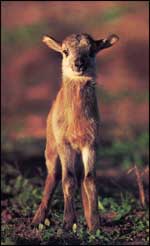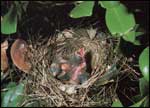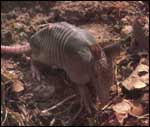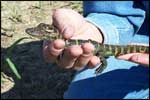Wildlife Babies

Exotic game is not protected by state and federal laws, but shouldn't this baby Corsican sheep be allowed to grow up in the wild?
Spring and early summer are those times of the year when most wildlife babies get their first look at the world that surrounds them. Unfortunately, when the warmer weather draws us into the outdoors for hiking, picnicking, camping, canoeing, and fishing, we come in contact with these tiny, seemingly helpless young and often do them harm.
Filled with good intentions and tender feelings of pity or love, we catch the poor wildlife babies and take them home so they won’t starve. The mistake we make is thinking that every young animal found by itself has been abandoned by its mother. Just as a human mother may leave her baby in the bedroom crib while she prepares the family’s dinner in the kitchen, a wildlife mother often must leave her young alone while searching for food. The wildlife baby is no more abandoned than the human child. Each mother knows where her young one was left, and each plans to return to it. In fact, it is possible that the wildlife mother is standing nearby watching and waiting for you to leave so she can come back to her little one.

Helpless as they may appear when you find them, wildlife babies are living in their natural environment. If you leave them alone, their mothers will continue to feed, protect, and teach them how to survive on their own in the outdoors. Your home is no place for them to live.
The wildlife baby is living in its natural environment. If you don’t interfere, its mother will feed, protect, and teach it to live and survive in the outdoors. And she knows far better than you how to care for it.
If you are unwise enough to take the young creature home, you are asking for problems. Wild animals are not meant to live in the comforts of your home. They are not housebroken and can leave a path of destruction that will amaze you. Sharp teeth gnaw the furniture and woodwork; claws shred upholstery, carpets, and expensive drapes; and little paws scatter the contents of bookcases, closets, and cabinets, breaking vases and other glassware. They don’t know they are destroying your property, nor do they care. They are just trying to follow their natural instincts in an unnatural environment.

Those same sharp teeth and claws that are wrecking things around the house also were meant to be used as weapons. You or members of your family, especially younger brothers or sisters, probably will be bitten, scratched, or otherwise hurt. As the young creature grows older and stronger, the severity of the injuries and the dangers increase in proportion. Another problem with bringing a wild animal into your home is that you may get more wildlife than you planned. Lice, mites, fleas, ticks, and worms are but a few of the parasites inhabiting the fur, feathers, and bodies of wild creatures. You also may bring home diseases such as rabies, viruses, and tetanus.
Probably the hardest
animal to resist is a tiny
fawn. However, before you
take part in any fawn-napping
attempt, you should know
it is against the law.
In fact, taking any game
animals, game birds, protected
nongame, or endangered
species as pets is illegal.

Picking up any wildlife baby and taking it home can be considered a crime against nature, but it may be illegal as well. The alligabor, an endangered species, is protected by state and federal laws.
The problems of taking wildlife from the wild are numerous, but the disadvantages are not all on the side of the humans. Look at the situation from the animal’s point of view. One minute it is being fed, trained, and cared for by its mother and the next minute its whole world is turned topsy-turvy. It is picked up and transported to a strange place by a creature it doesn’t recognize by sight or smell. Attempts to fight back produce uncomfortable results. Mealtimes bring strange foods it may not be able to eat or foods that make it sick or give it diarrhea.

If you truly love wildlife, don’t condemn animals to this fate—leave young wildlife alone. You’ll be doing them and yourself a favor.
Ilo
Hiller
1983 Wildlife Babies.
Young
Naturalist. The
Louise Lindsey Merrick
Texas Environment Series,
No. 6, pp. 13-14. Texas
A&M University Press,
College Station.